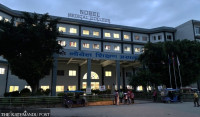Koshi Province
Development of planned towns in the hills fails to gain momentum
The government had a design to build such towns in 10 places nine years ago. Till date, it has little to show for work..jpg&w=900&height=601)
Chandra Karki
The government’s plan to build a modern town in Basantapur, Tehrathum, along the Mid-Hill Highway is going at a snail’s pace.
The authorities concerned started construction of the town in Basantapur nine years ago with an objective to control the rate of migration from the hilly settlements. But till date, construction works have failed to gain momentum so far.
Roshan Subedi, chairman of Basantapur Chamber of Commerce and Industry, said around 30 percent work for town establishment completed so far. “The construction works are not showing progress. We are doubtful about the timely completion of this project,” he said.
In 2011, the Ministry of Urban Development had selected 10 places—including Basantapur of Tehrathum, Phidim of Panchthar, Burtibang of Baglung, Dumre Bhansar of Tanahun, Baireni Galchhi of Dhading, Khurkot of Sindhuli, Chaurjahari of Rukum, Rakam Karnali of Dailekh, Sanfebagar of Achham and Patan of Baitadi—to be developed as modern towns. The government aimed to complete the project within 15 years, with a budget of Rs5 billion for each town.
According to the proposed modern town plan, the construction of roads, bus park, schools, colleges, hospitals and other infrastructures should have been underway in Basantapur. But not a single infrastructure has been completed or is near completion so far.
Surendra Subba, deputy chief at the project’s office in Basantapur, said, “We have budget shortage, disputes regarding the plan in the local level, shortage of workers, land dispute and lack of proper government policy.”
According to him, the government increased the proposed number of modern towns from 10 to 40, by including several other places of hill and Tarai, but did not increase the budget for the project.
According to the government’s plan, the proposed new towns will have well-paved roads, drinking water supply, educational institutions, hospitals, fruit and vegetable markets, industrial areas, bus parks, open spaces.




 17.12°C Kathmandu
17.12°C Kathmandu













